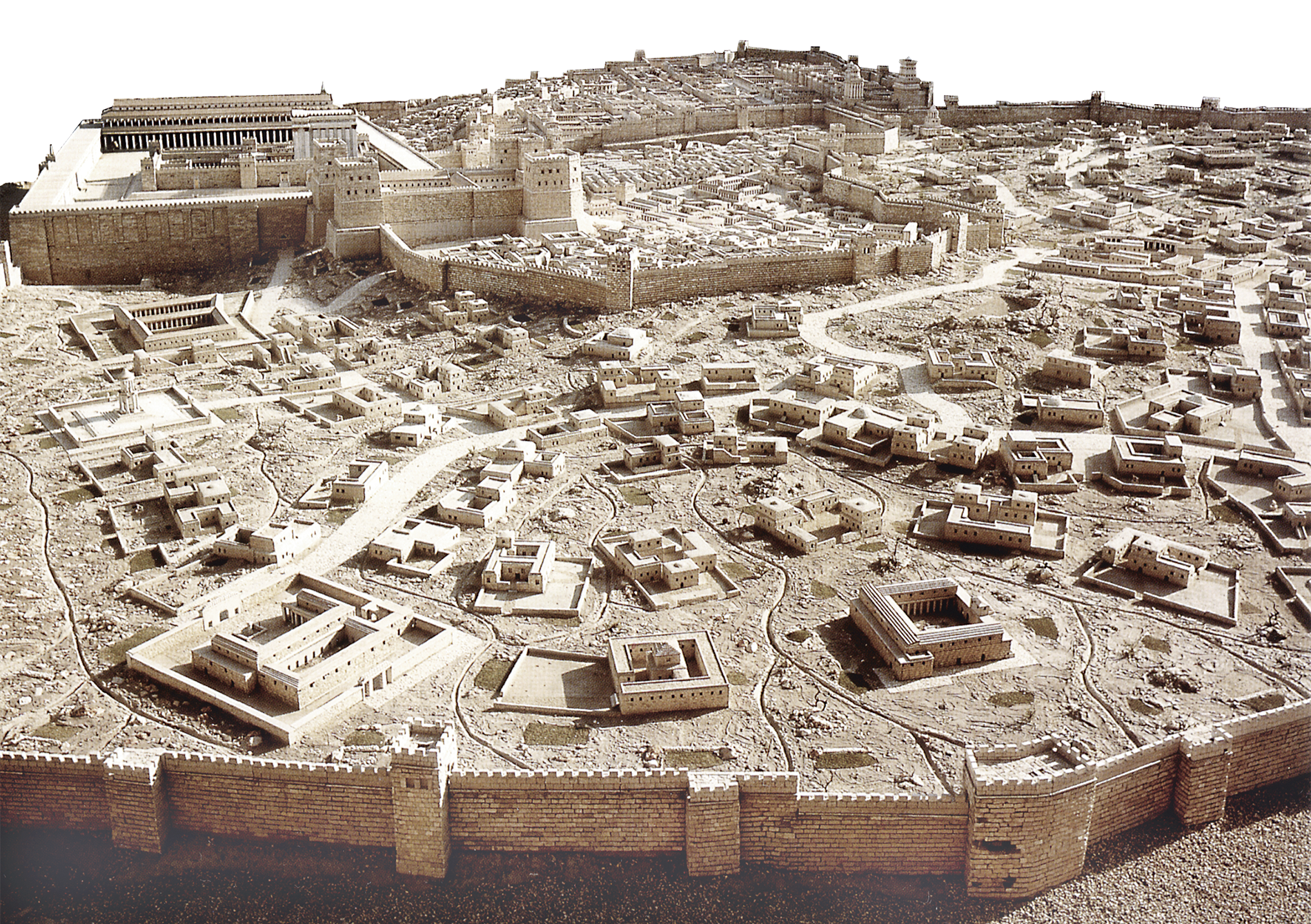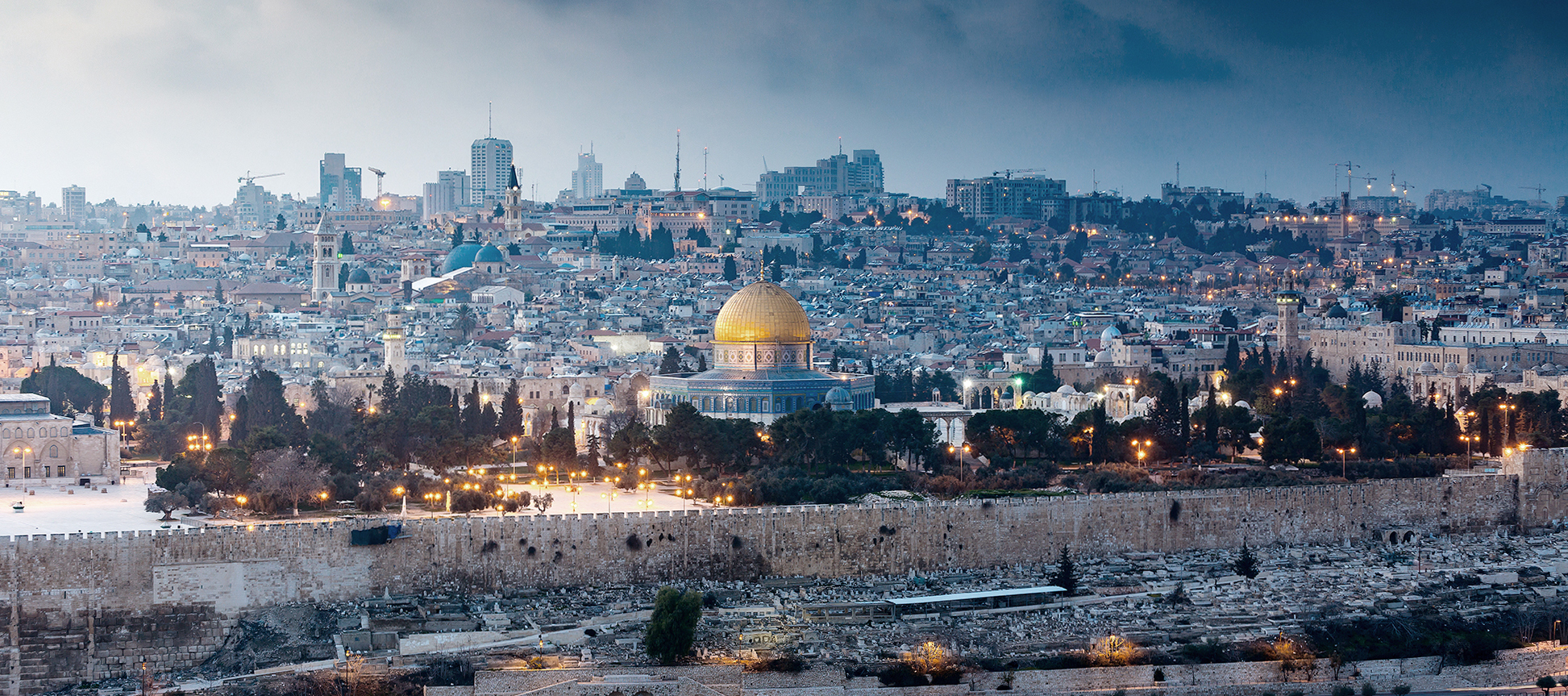
Bible, History, Archaeology
Bible,
History,
Archaeology
The four Temples of the Bible
In this dossier, we have deliberately left out the Temple of Ezekiel's vision and the one mentioned by the apostle John in Revelation, both of which are part of a prophetic vision.
According to the Holy Scriptures, four Temples were erected among the people of Israel:
The Tabernacle
The Tabernacle, unlike the three temples that succeeded it, was an edifice made up of elements that could be entirely dismantled and transported. It was intended as a sanctuary during the wanderings of the Hebrew people in the Sinai desert, probably between the 14th and 12th centuries BC.
Image opposite General view of the Tabernacle, with the cloud reminding us of God's presence (Shekina). It faced the rising sun. © D.R.
Construction
The Scriptures tell us how Moses received a vision of the Tabernacle on Mount Sinai, as he was to have it built, to be the «Dwelling Place of God» in the midst of his people.
The layout of the Tabernacle, with its three parts: the Parvis, the Holy Place and the Most Holy Place, was therefore designed according to the precise directives of the Lord. It was oriented towards the east, facing the rising sun.
The Tabernacle was placed in the midst of the twelve tribes of Israel, each of which was assigned a well-defined location and, in particular for the Levites, specific functions. The Levites, under the leadership of the High Priest, were responsible for the various accessories of the Tabernacle.
Sunrise on the probable Mount Moses (right) in southern Sinai. Mountains Hunter. 1246113445.
Le Temple de Salomon - The First Temple
The first Temple was built in Jerusalem in the 10th century BC. According to the Scriptures, its construction began in the fourth year of Solomon's reign (~ 964 BC) and was completed in seven years and six months. It was completely destroyed and razed to the ground in 586 BC by the Neo-Babylonian armies of Nebuchadnezzar II (The Nebuchadnezzar of the Bible).
Its construction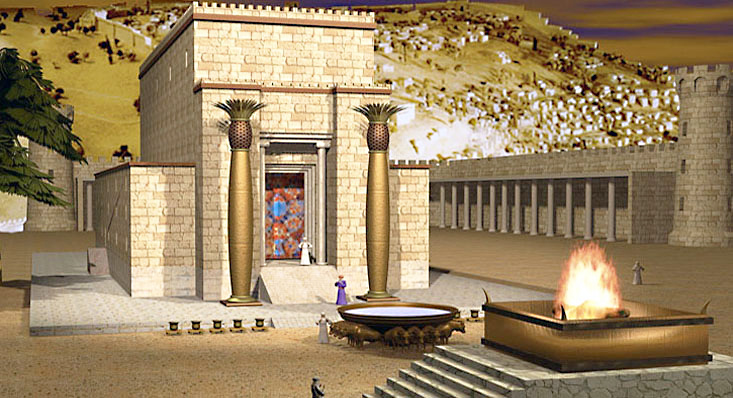
The sanctuary was erected by Solomon on Mount Moriah, on the site of the threshing floor of Ornan the Jebusite (2 Chronicles 3, 1), and again according to the Bible, at the place of «the binding of Isaac» (traditionally called the sacrifice of Isaac).
The general layout reproduced that of the Tabernacle, but was larger and more lavishly decorated.
 Images opposite Two possible versions of Solomon's Temple.
Images opposite Two possible versions of Solomon's Temple.
Top image The version with the covered vestibule.
Bottom image The version with the vestibule open.
Théo Truschel.
The interior of the sanctuary was 60 cubits long by 20 wide; its height 30 cubits (1 Kings 6, 2) differed from that of the Tabernacle, which was only 10 cubits high (the cubit is measured at around 47 cm). The Temple consisted of three distinct parts: The Parvis, the Holy Place and the Most Holy Place.
The walls were carved in stone and panelled from top to bottom. Numerous cherubs, palms and flowers were carved on the walls. The roof and ceiling were made of Lebanese cedar (1 Kings 6, 9). A parquet floor of cypress planks covered the floor. The entire interior was plated with gold: «And the whole house was covered in gold.» (1 Kings 6, 22).
Its destruction
Throughout Israel's royal period, several kings drew on the Temple's treasures to buy political power or peace. It was during the reign of King Josiah (~ 640-609 BC) that major restoration work began (2 Kings 22, 4).
In 586 B.C., Jerusalem was besieged, taken, the Temple looted and destroyed by the Neo-Babylonian army of king Nebuchadnezzar II.
Today, no trace remains of the work undertaken by Solomon. Subsequent construction on and around the Temple Mount, particularly by Herod, has obliterated the older structures that once stood there. At present, archaeological excavations to find some remains of Solomon's Temple are encountering insurmountable political and religious obstacles, as they would involve touching the Esplanade of the Mosques, a Muslim place of worship built on its probable site.
In the absence of direct evidence, we can consider the following:
- The existence of an erected temple-fortress at Arad, northeast of Bersabee, dating from the 10th century BC (probably the time of Solomon) and whose general configuration - a Holy Place, a Most Holy Place and an altar built of rough stones held together with clay in accordance with a prescription in Exodus 20:25 - corresponds to a Hebrew place of worship.
- The recent discovery of an ostraca (inscription on pottery fragments), dated to the 8th-7th century BC, which includes the following text:
«...as you were commanded by Ashyyahu, the king, to give through Zakaryahu the money of Tarshish for the Temple of Yahweh: three shekels».
This offering was destined for the Temple of Yahweh (i.e. the Temple of Jerusalem). This is the first time such a gift has been mentioned in an extra-biblical text. Some have taken it as an allusion to King Josiah (~ 640 B.C.).
 The Temple of Zorobabel
The Temple of Zorobabel
The second Temple is that of Zerubbabel, prince of Judah. Rebuilt by the Judaeans on their return from exile around 531 BC, it is thought to have been completed around 515 BC under the Medo-Persian Empire. Little is known about this work. What we do know is mostly contained in the books of’Ezra, Haggai, Nehemiah and Zacharie as well as in some historical sources under the reigns of the Hasmonean kings.
Image opposite A general aerial view of the Temple Mount in Jerusalem.
One of the few reliable historical sources relating to this period is the work of the Jewish apologist Joseph ben Matthias, also known by the Roman name of Flavius Josephus. Initially a priest in the Temple of Herod the Great in Jerusalem, Josephus became one of the leaders of the Jewish revolt in Galilee in 66 AD. This revolt was harshly put down by the Romans. After rallying to the victors in Judea, he accompanied Titus to Rome and began a career as historian, chronicler and advocate of Jewish culture to the oligarchs of the Empire. In a polemical work entitled Against Apion, Josephus cites a description of Jerusalem by Hecataeus of Abdera, a Greek historian who lived at the end of the 4th century BC and was a contemporary of Alexander the Great. The Temple he describes is the one built at the time of Ezra and Nehemiah:
«Near the center (from Jerusalem), A stone wall surrounds an area of five plethrons (a plethron is approximately 30 metres long by 50 metres wide). This area is accessible through two doors. Within this enclosure is a square altar, built with stones neither cut nor sealed, but only assembled. Each side measures twenty cubits long (~ 10 meters) and ten cubits high (~ 5 meters). Nearby is a large building containing an altar and a menorah, both of solid gold and weighing two talents.» (Against Apion 1, 198).
In biblical tradition, the period of Persian domination is marked by three major events: the restoration of the Temple (~ 515 BC), Nehemiah's rebuilding of the walls of Jerusalem (~ 445 BC) and the promulgation of the Law by the priest Ezra. These were the key factors in the re-establishment of the Jewish community after the Babylonian captivity. The need to preserve the Jewish people and their way of life from outside influences was strongly felt.
Three royal edicts were pronounced in favor of the Jews by the rulers of Persia:
Around 538 BC, one year after the capture and fall of Babylon, King Cyrus II the Great proposed that the Judeans return to Jerusalem to rebuild the Temple (Ezra 1,1-4). He returned all the utensils from Solomon's Temple seized by Nebuchadnezzar II and appointed Zorobabel governor of the colony. Led by this prince of Judah, the high priest Joshua and other princes, a number of Jews returned to Jerusalem. Joshua, the religious leader, and Zerubbabel, the political leader, erected an altar to the Lord and restored worship (Ezra 3:1-9). Opponents of the Jews then turned to successive Persian kings and succeeded in temporarily halting the work until 520 BC (2nd year of Darius Hystape).
Around 520 BC, King Darius encouraged the resumption of Temple construction, which had been interrupted by the enemies of the Jews (Ezra 6:1-12). Construction of the Temple was completed in the early spring of 515 B.C. (Ezra 6,14-15 ; Haggai 1 and 2 and Zacharie 4). The Second Temple is often referred to as the Temple of Zorobabel. This prince, a descendant of King David, was one of the direct ancestors of Jesus Christ (Matthieu 1,12-13).
Around 445 BC, Artaxerxes I, son of Xerxes I, drew up an order in Nehemiah's favor, authorizing him to rebuild the city wall of Jerusalem (Nehemiah 2,8).
He authorized Ezra and later Nehemiah to return to Jerusalem. He gave Ezra a letter entrusting him with the civil and ecclesiastical affairs of the Jewish nation. A copy of this decree can be found in Ezra 7,12-26.
He is said to have left Babylon, in the first month of the seventh year of Artaxerxes I's reign, at the head of the Jews, who included priests and Levites. Some historians believe that this event took place during the reign of Artaxerxes II.
A general view of the model recreating the city of Jerusalem at the time of King Herod the Great and Jesus of Nazareth. The Temple erected by Herod can be seen in the top left of the image. Israel Museum, Jerusalem. Israel Museum.
The Temple of Herod the Great
The Third Temple (the «second» of the name), a large complex in Greco-Roman style, built by Herod the Great, was destroyed in 70 AD during the siege of Jerusalem by Titus' Roman army. One of the few remaining vestiges is the Kotel: the Temple's western retaining wall.
Its construction
To reconstruct this prestigious edifice, three sources are at our disposal: the Bible, the writings of Flavius Josephus and the Middot (treaty) from Mishna.
Using the remarkable skills of the Romans, Herod embarked on major construction projects from 25 to 13 BC: the theater, the amphitheater and the walls of Jerusalem. He restored the Antonia fortress (where the apostle Paul was later imprisoned), which guarded the Temple and connected to his palace via a tunnel.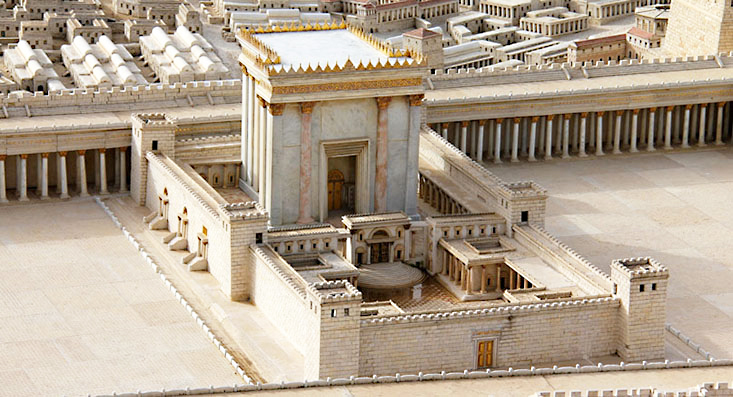
Image opposite A model of Herod's Temple on display at the Israel Museum in Jerusalem. Israel Museum.
As Herod began to develop a cult following of the Emperor, he made a commitment to the priests of Jerusalem to rebuild the Temple. The project was absolutely gigantic, and the work lasted nearly 80 years...! In other words, it involved the three generations of Herodians who ruled Judea. Begun around 20/19 B.C., the work was not completed until 64 A.D. Although Herod did not see the end of his project, it was well advanced by the time of his death. The Temple itself was finished, and the focus was on the huge porticoes built around the perimeter and on the surrounding wall.
Herod's idea, retained by the text of Flavius Josephus (Jewish Antiques, book XV), was to enlarge the dimensions of the Temple enclosure of Zorobabel's time and raise the site to a more imposing height.
Image opposite: Orthodox Jews celebrate the Feast of Booths (Sukkot) in front of the Kotel. It commemorates the Hebrew people's sojourn in the desert © Todd Bolen.
In 10 A.D., the Dedication of the Temple was celebrated. This feast of the Dedication should not be confused with the one mentioned in John 10:22, which concerns the Dedication of the Temple during the Maccabean revolt.. Occupied by the Seleucids (Greeks), Jerusalem was retaken by Judah Maccabaeus (164 BC), the Temple cleansed and the worship of the Lord restored. This event is still commemorated by the Jewish festival of Hanukkah also known as the «Festival of Lights» (November or December, depending on the calendar).
Its destruction
To understand the revolt of 66, which led to the destruction of the Temple and Jerusalem by the Roman army, it is useful to take into account the multiplication of religious conflicts mixed with political contestation exacerbated by the presence of foreigners.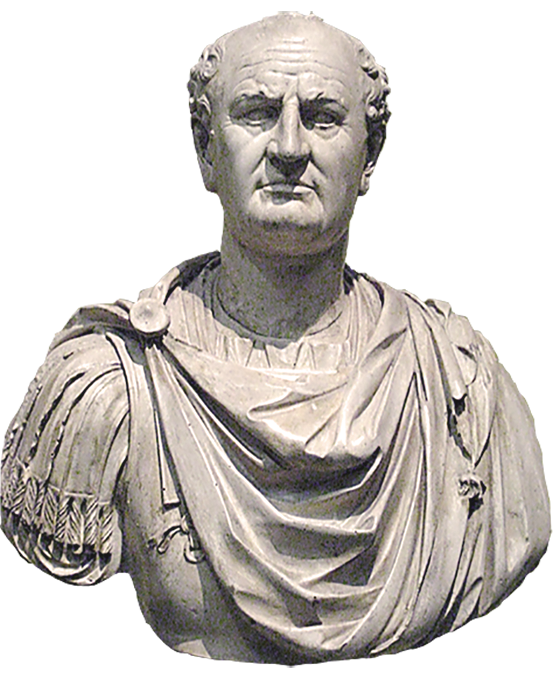
At the beginning of 70, Titus, with four legions, laid siege to Jerusalem, protected by its three walls. According to Flavius Josephus, the Jews had 20,000 armed men facing them. The Romans filled in the ditches and positioned their war machines, and on May 25, Titus took the first rampart. On May 30, the second. Titus offers the insurgents to surrender, and although the city is in a state of famine, they refuse. Titus completely overran the city; on July 20, the Antonia citadel was taken. On August 27, the final assault was made on the Temple, which was set on fire.
Image ci-contre: bust of Emperor Vespasian, founder of the Flavian dynasty,
Musée du Louvre. © Shako.
All that remains is to reduce Massada the refuge of the last Zealots under Eleazar's command. The Herodian fortress was not taken until May 2, 73. All but two women and five children of the 960 people still holding out were reported to have died. One million one hundred thousand people perished in the fighting or as a result of famine.
Judea loses all autonomy. The didrachm formerly paid to the Temple of Yahweh is paid to that of Jupiter. The land of Israel was no more than a consular colony. When the victorious Titus returned to Rome, he received a triumphal welcome from his father, Vespasian, who had left him in charge of the campaign's conclusion. The spoils and the prisoners are displayed throughout the city for all to see.
The Temple Mount today. In the center of the image, the Dome of the Rock or the Dome of the Rock, sometimes wrongly called the Mosque of Omar, «the first monument that was intended to be a major aesthetic creation of Islam», is a sanctuary erected at the end of the VIIᵉ century by order of the Caliph Abd al-Malik ibn Marwan. The al-Aqsa Mosque, Islam's third holiest site after Mecca and Medina, can be seen on the left © Kanuman 789501574.
A model of the Temple of Jerusalem in the time of Herod the Great. Israel Museum, Jerusalem.
A scale model of the Temple of Jerusalem at the time of Herod the Great.
Model of the reconstitution of the Antonia fortress adjoining the Temple erected by Herod the Great. © D.R.
Model of the reconstituted Antonia fortress adjoining the Temple.
General view of Jerusalem today, from the Mount of Olives. © D.R.
General view of Jerusalem today, from the Mount of Olives.
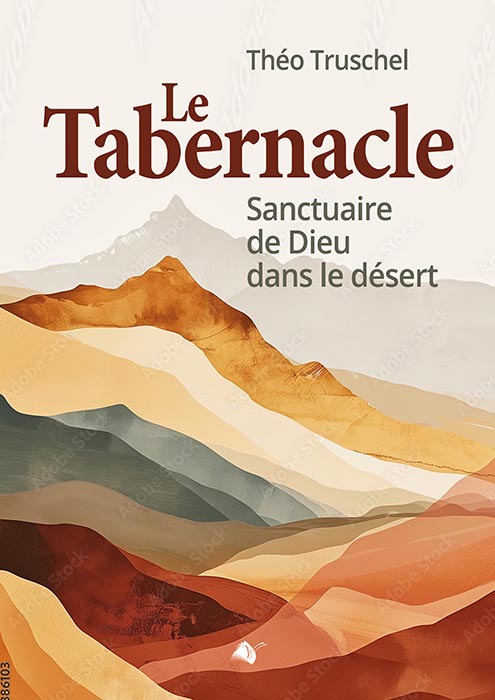
Find out more
TRUSCHEL Théo, The Tabernacle, God's sanctuary in the desert.
History and Archaeology Collection.
Éditions Viens et Vois, February 2024.
New expanded edition : Featuring a wealth of additional commentary, this book is also enriched by photos, including of Jebel Moussa (Mount of Moses, in Arabic), taken by the author in Sinai, the place where the Torah was revealed to Moses. It was here, according to Jewish, Christian and Muslim traditions, that the meeting with the Lord took place after the exit from Egypt, and where Moses received the vision and instructions for the construction of the Tabernacle, the Hebrew people's first place of worship towards their God. It's moving to see, in detail, how the craftsmen executed each and every element of the Tabernacle, how they worked very precisely with wood, fabrics, gold, silver, precious stones, while they were in the middle of the desert. Each detail of the Tabernacle has a symbolism that still speaks to us today and, for Christians, heralds the work of Jesus Christ, the Son of the living God.

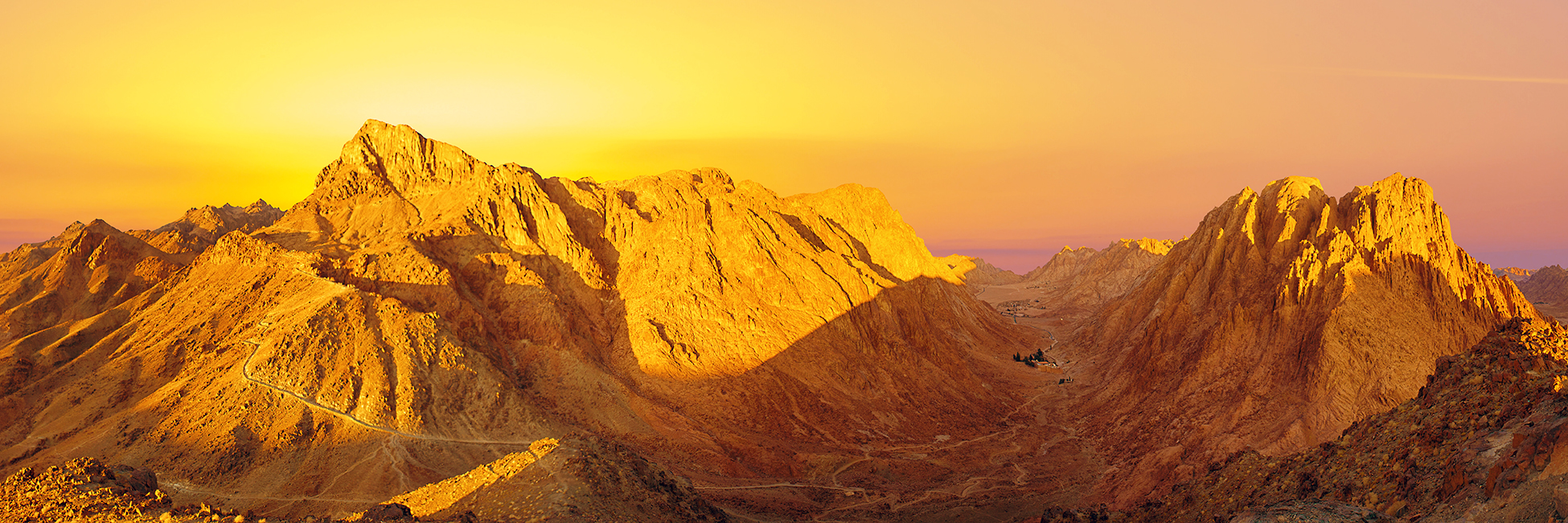
 Images opposite Two possible versions of Solomon's Temple.
Images opposite Two possible versions of Solomon's Temple.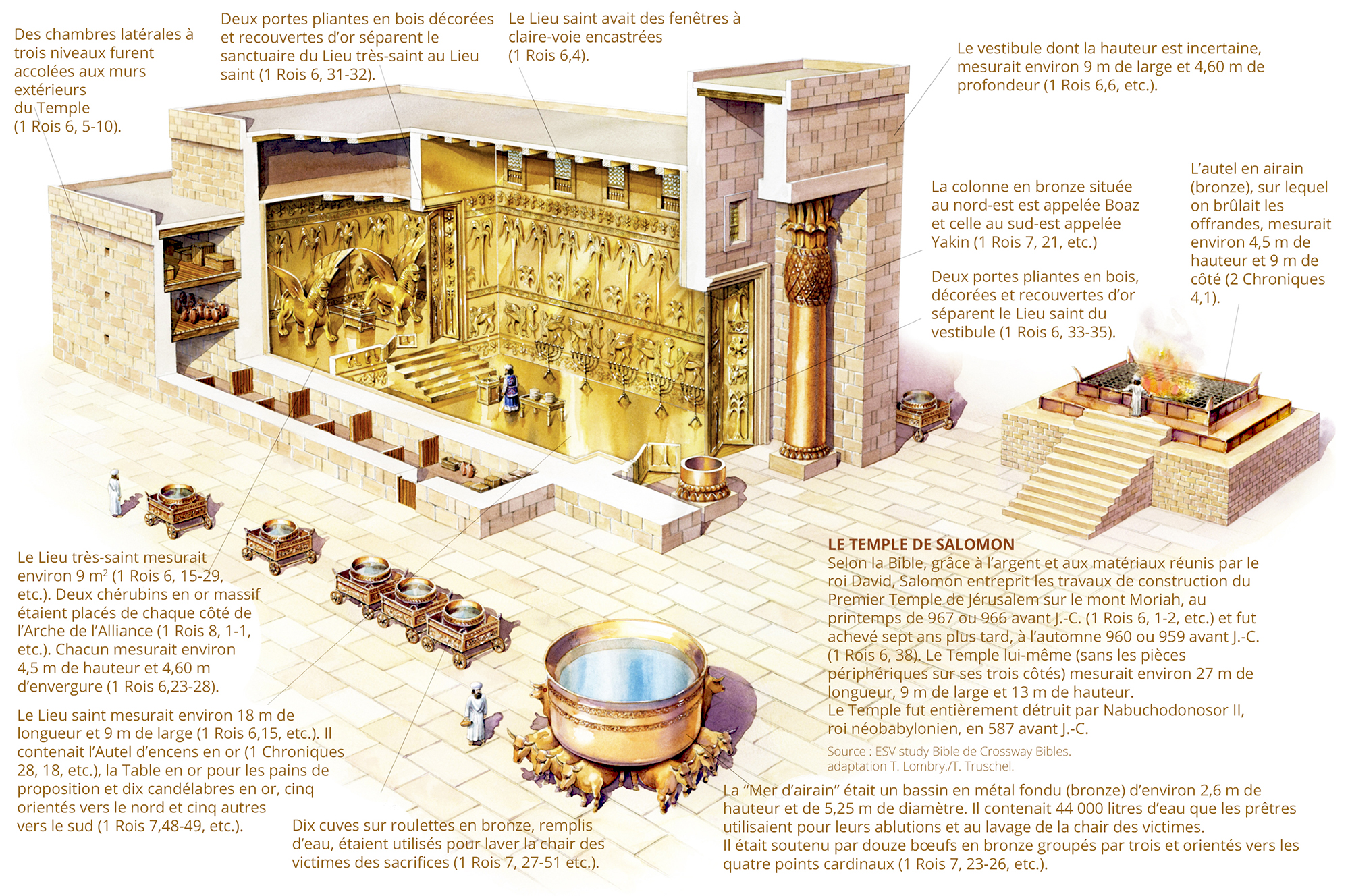
 The Temple of Zorobabel
The Temple of Zorobabel